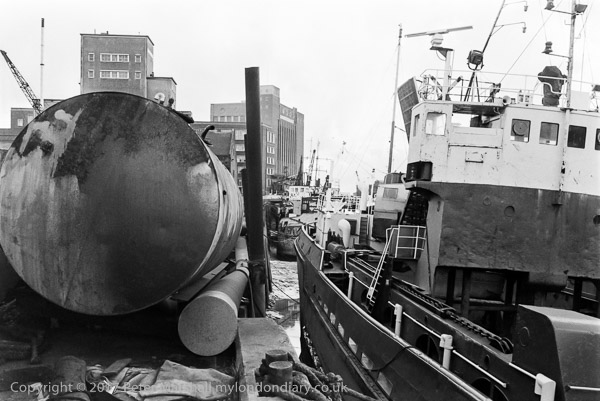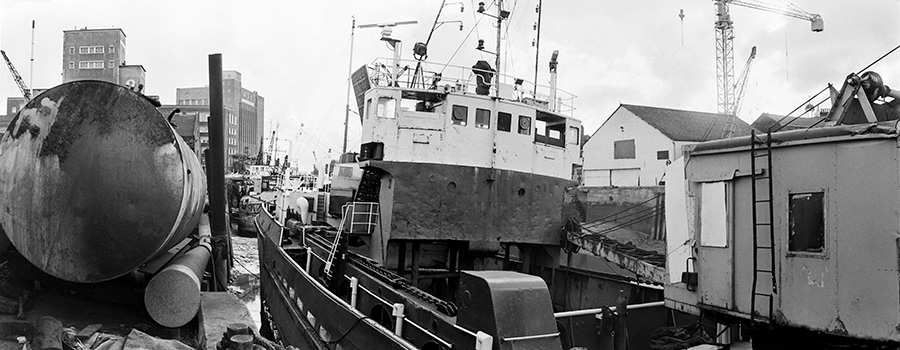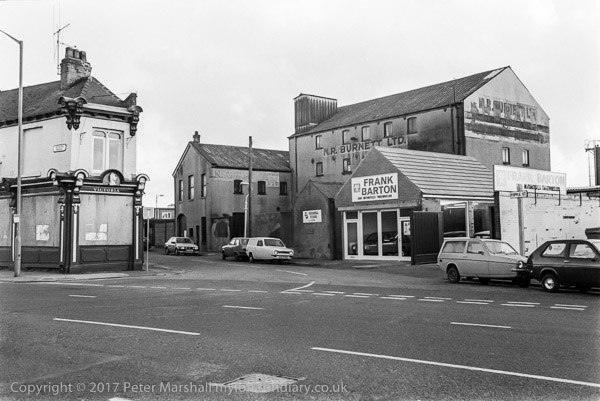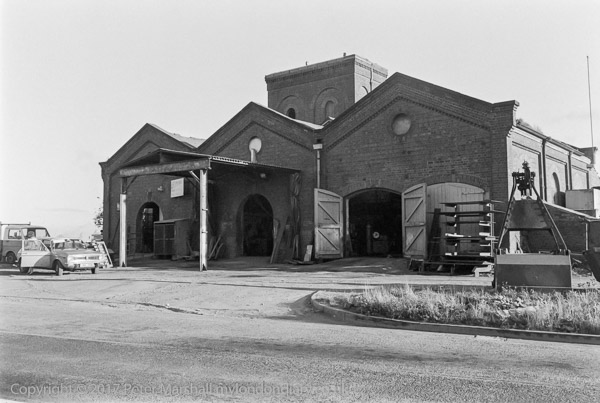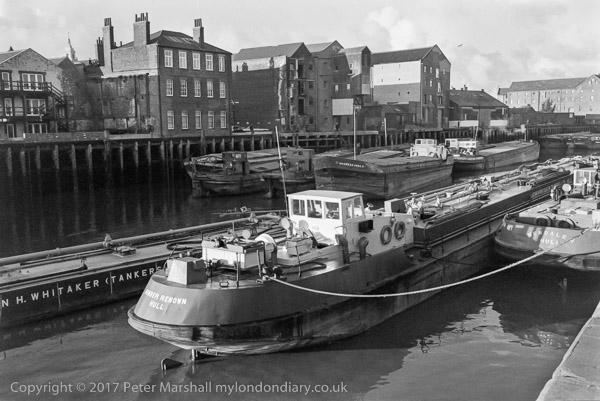Another digest of my daily posts during Hull2017 on Facebook, about the pictures added daily on the intro page at Hull Photos. Comments and corrections to the captions and texts about the pictures are always welcome here or on Facebook.
Hull Photos
16th December
In the distance are the raised Drypool Bridge, apparently under repair and on the left the Clarence Flour Mills. On the left the moored dredger, Burcom Sand, with a barge moored alongside. Under the bridge can be seen the Trinity House Buoy Shed and immediately to its right an old warehouse. Below this is the entrance to a dry dock and then to the right one of two sheds belonging to the Yorkshire Dry Dock Co Ltd, Shipbuilders ship repairers – as it helpfully states on the second shed at far right. Between the shed is the entrance to Queen’s Dock Basin, converted to use by the company as a dry dock at some time after Queen’s Dock was filled in during the 1930s.
A large crane towers over the shipyard, and another just intrudes at the top left. Clearly there was building work going on on both sides of the River Hull, though not actually on its banks.

85-10l-65: River Hull from North Bridge, 1985 – River Hull
17th December
Studio Ann Carlton was started in 1969 when Anne Finestein made a unique chess set for her husband and other chess players wanted copies. Soon the business outgrew her garden shed and she moved into a former fish smoking house on Flinton St. The company was acquired by Clayhithe Plc in the early 1980s who built a modern factory on the site. This closed after the company was bought by Traditional Games who closed the factory and moved production to China. In 2014 the rights to SAC were bought by Ancestors’ of Dover Ltd and the expensive (and to my mind rather ugly) chess and backgammon sets are now produced in Folkestone.
The building is still there, though now the roof is blue rather than the red-brown when I took this picture (not that this shows in the black and white image.) The nearer buildings on the left have been replaced, but further down the road the premised of Batty Joiners are still in use.
Batty Joinery was established in 1919 as a bespoke joinery manufacturers and is still crafting high-end traditional joinery products, employing around 30 skilled workers. It became part of the Hall Group in the 1960s, but fortunately returned to independence and so was not affected when the Hall Group went into administration in January 2017.

85-10m-01: Studio Anne Carlton, West Dock Ave & Flinton St, 1985 – Hessle Rd
18th December
Maconochie Seafoods were incorporated as a private Limited Company in 1969 and apparently ceased trading around 1991.
F Smales & Son (Fish Merchants) Limited, ‘Famous for Fish Since 1937’ are now based in a more modern and rather larger building on West Dock Street, as well as a giant shed on Gillett St and Witty St. Their activities are stated at Companies House as: Processing and preserving of fish, crustaceans and molluscs and Wholesale of other food, including fish, crustaceans and molluscs. Started by Tim Smales on the Hull Fish dock it is still a family firm, operating in three main industry sectors, fish and chips, food service, all based around fish and seafood.
The distant view down the road appears to be of the docks, but I am unsure of the precise location. It was the next picture on the film after that taken on the corner of Flinton St and West Dock Avenue. I think all of the buildings in the picture have probably been demolished, with much of the area covered by more modern shed-like buildings.

85-10m-02 Maconochie Seafoods and F Smales & Son, Flinton St area, 1985 – Hessle Rd
19th December
Scaflon Marine Ltd were on Earles Rd, at the north east edge of Victoria Dock, off the Hedon Rd. The company which repaired ships and containers was incorporated as a private limited company in 1981 and went into liquidation in 1998.
It looked as if what had perhaps previously been an open timber shed had been rather crudely enclosed using sheets of plywood, the wood grain of its outer veneer clearly showing.
Perhaps because this building was on the side one of Hull’s few hills, coming up from Victoria Dock, my attempts at levelling and squaring up the image were even less successful than usual. That could have been corrected either in the darkroom or now on computer, but I have left it exactly as taken.
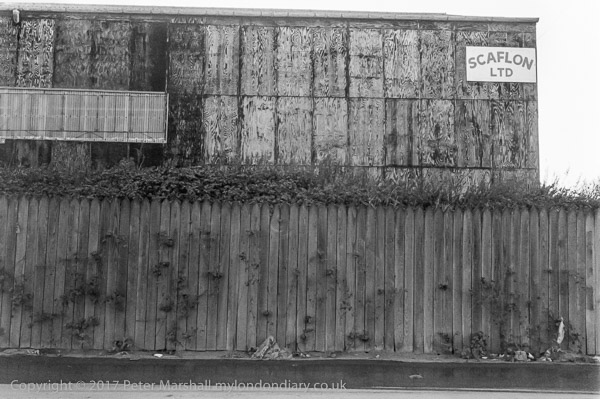
85-10m-21: Scaflon Ltd, Earles Rd, 1985 – East Hull
20th December
Another picture of Scaflon Ltd, and one of the few hills in Hull, coming up from the dock.
Earle’s Road led to the shipbuilding company started on the bank of the Humber by brothers Charles and William Earle in 1845 and saved from extinction when bought by Charles Wilson of the Wilson Line in 1900. In 1932 it was taken over by the National Shipbuilders Securities (NSS), a government sponsored scheme to rationalise the shipbuilding industry by selling most of it off. They sold off Earle’s machinery and tools, mainly to Kowloon in Hong Kong, and set a restrictive covenant on the site which forbade any shipbuilding there for the next 60 years.

85-10m-22-: Scaflon Ltd, Earles Rd, 1985 – East Hull
21st December
A picture taken on my way back from Victoria Dock to the City Centre. There appear to be two lanes on the road, so this was Hedon Rd, largely replaced by a new A63 after the opening of the Myton Bridge a few years earlier.
Although the building in the middle of this image is boarded up, there is a lit fluorescent tube visible in the window at the extreme left, showing it still to be in use.
Many of the buildings along Hedon Road were saw mills, as Victoria Dock was a major timber dock for the UK, bringing in timber from Scandinavia and the Baltic.

85-10m-23: Buildings on Hedon Rd, 1985 – East Hull
22nd December
The right half of this image shows the Victoria And Continental Coffee Club, on the south-east corner of Great Union St and Clarence St. Gamebore Cartridges are still in business and using the same buidling, formerly a part of Rank’s flour mill immediately to the north of Drypool Bridge.
The Coffee club site is now part of the Travis Perkins yard, piled with building materials. I’m told it was a notorious Hull nightspot, open after the pubs had shut at 11pm, and although officially the only drink was coffee, others were available under the counter, including some toxic home-brew whisky. It was a part of Hull’s red light district its southern dockside edge, and allegedly this and the ‘Monkey House’, the Victoria pub a short distance along the Hedon Road, were popular places to find prostitutes.
The Club was still open when I took this picture, but closed down some time around 2000, and a few years later burnt down in a mysterious fire, a fate rather common in Hull.

85-10m-25: Great Union St and Clarence St looking north, 1985 – East Hull
Earlier today I published the final image in my daily posts for Hull2017 to Hull Photos, with my short comments on Facebook.
Comments and corrections to the captions of any images on the site are still welcome on the posts here or to me on Facebook.
Although the year-long project has ended I will still be putting more pictures on the site, but just not one every day – probably in occasional batches. I’ll try to remember to post about these here and on Facebook.
Continue reading Hull Photos: 16/12/17 – 22/12/17

